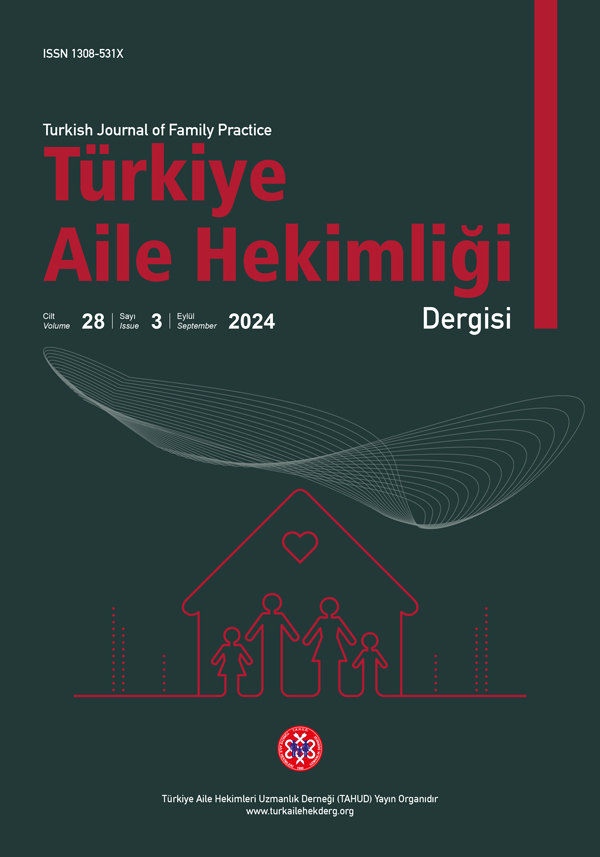





1.Basamak Sağlık Merkezlerinde KOAH ve Astım’lı Hastaların İnhalasyon Cihazlarını Kullanma Becerilerinin Değerlendirilmesi
Vedat Arslan1, Burcu Oktay Arslan2, Mehmet Esat Özdemir11Şemikler 7 No lu Aile Sağlığı Merkezi, Karşıyaka, İzmir..2S.B. Dr.Suat Seren Göğüs Hastalıkları ve Göğüs Cerrahisi Eğitim ve Araştırma Hastanesi.
GİRİŞ ve AMAÇ: İnhaler cihazların doğru kullanılması kronik obstrüktif akciğer hastalığı (KOAH) ve astım yönetiminde oldukça önemlidir. Bu çalışmada; birinci basamak sağlık merkezlerine başvuran KOAH ve astım tanılı hastaların inhalasyon cihazı kullanım becerilerinin değerlendirilmesi ve doğru ve yanlış kullanım ile ilgili faktörlerin belirlenmesi amaçlanmıştır.
YÖNTEM ve GEREÇLER: Aile sağlığı merkezimize başvuran, KOAH ya da astım tanısı ile inhalasyon cihazı kullanan,18-80 yaş aralığında hastalar çalışmaya dâhil edildiler. Hastaların demografik bilgileri kaydedildi ve inhalasyon cihazlarını kullanmaları istendi. İnhalasyon cihazı kullanma tekniği, inhalasyon cihazı kullanım beceri çizelgesine göre puanlandı ve beceri skoru elde edildi. Beceri skoruna göre kötü, orta ve iyi kullanım düzeyleri belirlendi. İnhalasyon cihazı, beceri skoru ve demografik özellikler arasındaki ilişki değerlendirildi.
BULGULAR: Çalışmaya 120 (62 erkek, 58 kadın) hasta dâhil edildi. Ortalama yaş 59±11,5 idi. Yüzde 51.7 hastanın KOAH, %48,3 hastanın astım tanısı vardı. Hastaların %56,7’si ölçülü doz inhaler (ODI), %20’si turbohaler, %20’si discus, %40,8’i kapsüllü kuru toz inhaler (aerolizer, handihaler, capsair, neohaler) kullanıyordu. İnhalasyon cihazı beceri skoru ODI için 4,4±2,77, turbohaler için 5,6±2,05, discus için 5,9±2,71 ve kapsüllü kuru toz inhalasyon (KKTI) cihazları içn 8±1,64 olarak belirlendi. ODI beceri skoru ile eğitim düzeyi arasında pozitif yönde anlamlı ilişki izlendi (r=0,400, p=0,019). KOAH’lı hastalarda KKTI cihaz kul
TARTIŞMA ve SONUÇ: En sık kullanılan ancak en düşük kullanım beceri puanı alan cihaz ODI’dir. KKTI cihazları ise doğru teknikle kullanım oranı en yüksek cihazlardır. Birinci basamak sağlık merkezleri KOAH ve astım tedavi yönetiminde inhaler cihazların doğru teknikle kullanılması aşamasında daha etkin rol alabilirler. Birinci basamakta hastaların inhaler cihaz kullanım becerilerinin değerlendirilmesi ve gereğinde yeniden eğitim verilmesi, bu hastalıkların uzun dönem sonuçları üzerinde olumlu etkiler yaratacaktır.
Assessment of the Skills of Using Inhaler Devices of the Patients with COPD and Asthma in Primary Health Care Centers
Vedat Arslan1, Burcu Oktay Arslan2, Mehmet Esat Özdemir11Şemikler 7 No lu Aile Sağlığı Merkezi, Karşıyaka, İzmir..2S.B. Dr.Suat Seren Göğüs Hastalıkları ve Göğüs Cerrahisi Eğitim ve Araştırma Hastanesi.
INTRODUCTION: Proper use of inhaler devices is essential in the management of chronic obstructive pulmonary disease (COPD) and asthma. The aim of this study was to evaluate the inhalation device usage skills of COPD and asthma patients who admitted to the primary health care centers and try to figure out suggestions for good inhalation technique.
METHODS: Patients aged 18 to 80 years, who applied to primary health care center with the diagnosis of COPD and asthma and using inhaler devices were included in the study. Demographic data of the patients were recorded. Patients were asked to demonstrate the use of their prescribed inhaler devices. Inhaler technique was assessed by the inhaler device usage scoring system. Skill scores for each inhaler devices were calculated. The relation between inhaler device, inhaler device skill scores and demographic parameters were evaluated.
RESULTS: In total, 120 patients (62 male, 58 female) were included in the study. The mean age of the study population was 59±11.5. Fifty-one point seven percent of the patients had COPD and 48.3% had asthma. Of those 56.7% of the patients were using metered dose inhaler (MDI), 20% were using turbohaler, 20% were using discus and 40.8% were using dry powder inhalers (aerolizer,handihaler,capsair,neohaler). Average skill scores for inhaler devices were 4.4±2.77, 5.6±2.05, 5.9±2.71 and 8±1.64 for MDI, turbuhaler, discus and dry powder inhalers (DPI) respectively. There was a positive correlation between ODI skill score and education level (r=0.400, p=0.019). In patients with COPD, use of DPI was more frequent and the average score was higher than in patients with asthma. (p=0.003, p=0.002 respectively).
DISCUSSION AND CONCLUSION: The inhaler device most used and has the lowest skill score was MDI. DPI was the devices with the highest rate of use with proper technique. Primary health care centers may play a more effective role regarding inhaler device use with proper technique in the management of COPD and asthma. Evaluating of the patients’ ability to use inhaler devices and retraining if necessary, will have positive impacts on the long-term outcomes of COPD and asthma.
Makale Dili: Türkçe








